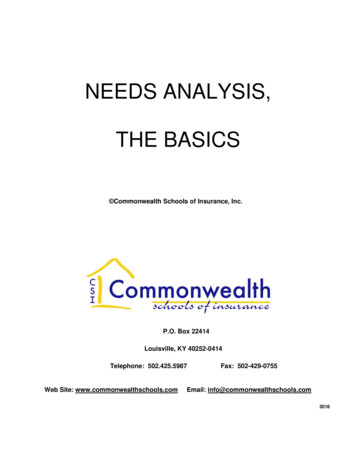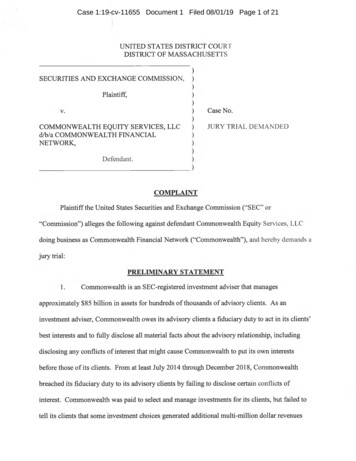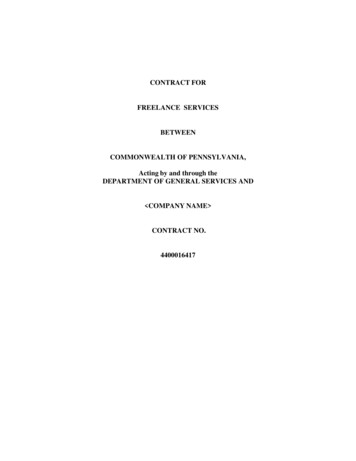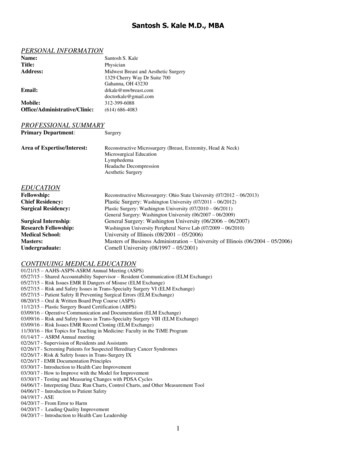
Transcription
NEEDS ANALYSIS,THE BASICS Commonwealth Schools of Insurance, Inc.P.O. Box 22414Louisville, KY 40252-0414Telephone: 502.425.5987Web Site: www.commonwealthschools.comFax: 502-429-0755Email: info@commonwealthschools.com2018
DISCLOSUREThis booklet is intended to provide you with accurate and useful information, ideas andapplications. However, the information contained herein is subject to change throughlegislation or from industry practice.This material is presented and distributed for educational purposes only. The materialdoes not constitute legal, accounting, or other professional advice. Commonwealth Schools of Insurance, Inc. Commonwealth Schools of Insurance, Inc.2
NEEDS ANALYSIS, THE BASICSINTRODUCTIONWhen analyzing your customer’s needs, there are a few simple steps that you may wantto start with over and above the information on the application. A simple way to startwould be by using the information below, remembering that this is just a starting point inbuilding your client’s profile to determine your client’s financial problems or deficienciesso that the prospect begins to recognize the actual need/deficiencies as well.A simple discussion to start the process should contain some, if not all of the followingtopics: Cash Management – is more than merely balancing a checkbook, cashmanagement includes preparing and following a budget, using credit wisely andkeeping the income tax burden to the lowest level possibleRisk Management – There is risk of loss of both life and property. Life insurancecan be used to protect a family against the risk of premature death. Disabilityinsurance can protect against the loss of a person’s ability to earn a living.Property and casualty insurance can protect our worldly goods against accidentand such perils as fire, flood, earthquake and theft. Health insurance can helppay the cost of needed medical care.Accumulation Goals – We all need to save money for some reason. Educatingour children is one very common goal. Buying a home and building aninvestment portfolio are two other typical accumulation goals.Retirement – Taking action in the present to insure the future.Rules of thumb or simple tests Quick tests are less specific than in-depth analysisBest used when time and premium are limitedQuick tests are simple to understandTypes of Simple Needs Analysis Annual income times number of years protection desiredFive Step Basic Security Test. Asks 5 questions: Do you have a minimum of 5 times income protection? Is your mortgage protected? Do you have at least one year of income protected in case of disability? Do you have 3 to 6 months of take-home pay in a liquid account? Do you have a medical reimbursement policy?After answering, plug in the numbers to meet basic security test. Commonwealth Schools of Insurance, Inc.3
Americans are among poorest savers in the world. Most families do not have 3 months of liquid savings.Average credit card debt per household exceeds 9,000.Interest rate on credit card debt is exorbitant.Needs analysis can address a strategy to assist better habits.Human Life Value Approach Determines what a person is worth economically over his lifetime.Factors to consider would be: Future income Years of earning potential Taxes Education and its impact on earnings Training and professional development InflationSimplified approach would be present gross earnings x number of years to retirement.Example:Male age 37, retirement at 67, 30 years of work at present gross earningsof 50,000 1,500,000 (Assumes no raises, no factoring of inflation)Having stated the above, which is a good place to begin, in the world of insurance,client's must decide when to insure, what to insure and how much to cover and pay. Asan agent, it is your job to analyze these needs and be an advocate or problem solver tomake sure the requested risk has been transferred. A client views policies in terms ofobtaining reduced uncertainty. In most cases, your customers can only hope that thepolicy they purchase is appropriate. That is why agents are vital players in solving clientneeds.Detailed Needs Analysis Cash Needs at Death Final Expenses Probate/Administration Expense Federal/State Taxes Last Medical Expenses Funeral Expenses ( 6,000- 12,000) Debt Mortgage All other debt Commonwealth Schools of Insurance, Inc.4
Emergency Fund 3 to 6 Months of survivor’s budget needs Should be separate from income needs Should be in a liquid account Income for surviving spouse should include 3 periods Dependent children at home Blackout period Retirement Social Security can be factored in if desired Education Funding Can use the current cost or factor in inflation Current cost of 1 year x number of years desired x number of children(Number of years is not necessarily 4) Add ALL cash needed to determine total List all cash assets to offset cash needs Life Insurance – both personal and group Cash Savings Liquidated value Pension benefits of the deceased if immediately available at death IRAs and other qualified programs if taken as a benefit to the survivor Social Security, if qualified Any other assets convertible to cash Total all amounts available at death then subtract the total cash available fromthe total amount required If the amount required is greater, life insurance could be part of the solution. After the amount of the life insurance is agreed upon, the next step is todetermine the type to use. Factors in determining type (whole life, universal life, term) could be: Premium Cost Client’s philosophy regarding term versus permanent Client’s history of saving (permanent can encourage) Client’s sophistication about investments/insurance Savings and investments currently in place Time frames for which coverage is needed Client’s health Single Need Approach Child-rearing years Mortgage Commonwealth Schools of Insurance, Inc.5
Outstanding LoansSurvivor IncomeCollegeSpecial NeedsHandicapped family memberLong-term CareRetirement needs in event of premature deathCapital Liquidation versus Capital Conservation How will the money be utilized at death and how long? Capital Liquidation (Utilization) Uses both principal and interest Logical for immediate disbursement of funds Used to fund income over a period of years; problem for lifetime income Disadvantage is it could erode fund prematurely Advantage is it takes a smaller amount of money. Capital Conservation (Retention) Uses interest only Can produce income indefinitely and never uses the principal sum Assumption of a reasonable interest rate critical Advantage: Lifetime income more assured than Liquidation Method Leftover corpus can be left to others.The preceding has been an introduction to determining needs. The following is more indepth in explain how to determine the required information.Suitability When Determining Client NeedsBeyond being, the most responsible agent you can be, you should size-up your clientand anticipate his needs when he cannot. How can this be accomplished?Aside from determining current and future risks that you know about, you need toexpect those that have not happened. For instance, you should know that a 50-year-oldbaby boomer client is a far more complex individual than his parents before him. Hisinsurance needs are also more complex: higher life limits to cover college andentrepreneurial pursuits; medical coverages, long-term care and more retirement needsfor a longer life span; higher primary and umbrella coverages to protect againstlawsuits.To really uncover as many of these client needs as possible, you must know moreabout your clients. Of course, a client profile is the best way to accomplish this.Customer profiles can provide a lot more information than you would gleam from anapplication. You must also ask clients what about their needs. Commonwealth Schools of Insurance, Inc.6
Three important questions might be: Have I given you all the information you need to make a decision?Does this information or policy make sense?Is there something else I can answer for you to assure you that thisis the right solution based on your needs and objectives?In addition, you should do research about their needs as a group so you can betteranticipate insurance needs. Every additional bit of information you learn about yourclient helps you get closer to knowing their goals, needs and wants.In some cases, your clients will not know the answers to your questions themselves –you may need to interpret for them. But, by all means NEVER do this without involvingthem in the process. And, of course, once you have asked all the questions you must besure that you implement or meet their needs to the best of your ability.Needs-Based AnalysisBeyond the issue of risk, traditional industry thinking tells us that suitability should bebased on needs. Needs analysis is a procedure to help prospective insurance clientsplan for their future.Needs-based analysis has been around since the early days but it was refined in thelate 1960s by Thomas J. Wolff, a tenacious and studious insurance agent, who is todayan industry legend. As a young agent, Wolff struggled to make it in the business.While other agents and teachers dazzled their audiences with tales of sales wizardryand artful cherry picking among the rich and famous, Tom Wolff told a much differenttale. Instead of trying to achieve his place by showing everyone how good he was, hetaught his students how effective they could be as agents through capital needsanalysis and financial needs analysis. Thus, began the beginning of the suitabilityapproach to selling insurance.The purpose of a needs-driven sales system is to analyze a client’s needs anddetermine how insurance can best meet those needs. It is not meant to generate thesale based upon the obvious points of the product or the need of the salesperson toproduce. It uncovers a prospect’s general financial problems or deficiencies so that theprospect begins to recognize the need.The problem is personalized to arouse interest in a possible solution. Like any system,needs analysis works effectively only when it is used as it is designed. The systembuilds upon itself in terms of both content and data and is most effective when usedfrom start to finish. Shortcuts undermine the effectiveness of the process. An agentfollowing this system from start to finish should never be accused of less thanprofessional point-of sale practices.Needs-based analysis goes into great detail in analyzing needs and creatingrecommendations that are based upon airtight logic and conclusions. Needs-basedselling involves the client, allowing him or her to use his or her own ideas and Commonwealth Schools of Insurance, Inc.7
assumptions. It is a process that allows the prospect to participate in creating his or herown solutions to needs based upon what he or she considers important. Analyses mustrepresent and respect the client’s opinions. The goals are those of the prospect, not theagent. If the goals are not the goals of the prospect, the prospect is not likely to goalong with the agent’s recommendations in the end.A COMPLETE SYSTEMNeeds-based selling is a complete system for obtaining the appointment, opening theinterview and gathering factual data for all types of prospects. At the end of the factfinding process, a joint decision is made between the prospect and the agent as towhich of three cornerstones of financial security is top priority: Accumulation (developing a sound plan to assist in paying for educationand for other financial objectives),Retirement (planning to provide the additional income needed tosupplement Social Security, pension plans, existing savings andinvestments) orProtection (planning to assure that obligations are met in the event ofdeath, disability or loss of property).Let's assume a life analysis was being conducted for a baby boomer client. Your factfinding will likely reveal that most boomers are underinsured and require more capital inthe event of death than other segments because they have large loans, college-boundteens, business income replacement, partner buyouts, spouse retirement needs, etc.Seniors, on the other hand, are “winding down” their lives with fewer protection needs.However, for those who have not planned as well, an in-force policy that can be sold asa life settlement to pay long-term care costs or small burial plan can be a real comfort.Performing Needs AnalysisThe needs analysis system breaks the sales process down into carefully engineeredparts:The Pre-approachThis step is designed to get an appointment under favorableconditions for a face-to-face meeting.The ApproachThe objective of the approach is to obtain the appointment. During theapproach, no detailed data-taking or selling takes place. Commonwealth Schools of Insurance, Inc.8
The Initial InterviewThe agent’s objective during this initial interview is to gatherinformation and uncover the dominant needs of a prospect. Informationsuch as name, birth date, spouse’ s and children’ s names and birthdates, address and telephone numbers, property owned and basicobligations are gathered at this time.Other information to obtain at this time is occupation, spouse’soccupation and whether or not the prospect is a smoker, works athome or engages in a high-risk occupation or hobby. A questionnaireis usually filled out at this point, rating his or her feelings, concerns andgoals in a variety of areas.Next, the prospect’s financial situation must be assessed. This part ofthe questionnaire covers such areas as annual income, total lifeinsurance, total assets and total liabilities, the value and the mortgageof the residence, and present investments (such as savings and CDs,money markets, mutual funds, real estate other than the residence,stocks and bonds, U.S. government bonds, IRAs, 401(k)s or othersalary savings plans, and pension or profit sharing plans).The questionnaire then assesses the prospect’s financial risk profile. Forexample, what kind of financial risk is he willing or able to take: Considerablerisk, almost none? Is he willing to take average risks in order to improve the rateof return? Is he or she willing to take substantial risks in order to maximize therate of return? In the next part of the questionnaire, the prospect is asked tomake expectations and predictions about his future. For example, will he bechanging jobs, starting a business, selling a business, receiving a promotion orretiring, buying a new home or car? Will he be buying a larger or smaller home,making improvements to a home, caring for a parent / spouse or changingmarital status? Does he anticipate getting a raise, getting a bonus, inheritingassets, borrowing money, paying off a loan or purchasing property?This initial interview begins the process of building trust. The initial interview andquestionnaire allow the agent to screen the prospect and then determine whetherto eliminate him or her based on the data gathered or to proceed with the sellingprocess. The data gathering phase of needs analysis is designed to helpunderstand people. It is often said that people don’t buy because they are madeto understand; rather they buy when they feel they are understood. The moretime that is spent in the effective gathering of both facts and feelings, the lesstime that will be needed to be spent on the close. Being sincerely interested inpeople will permit them to be openly interested in the full presentation.The ReviewAfter the prospect completes the questionnaire, the agent reviews it quickly andlooks for areas of importance. The agent may discover, for example, that theprospect is not satisfied with his current premiums, the percentage of income he Commonwealth Schools of Insurance, Inc.9
or she is saving, that he or she does not have an understanding of trusts or thathe or she does not participate in a pension or profit-sharing plan.The relationship should be terminated if the prospect is uncooperative, if his orher needs do not meet the agent’s minimum requirements, area of knowledge orif insurability does not permit the agent to offer help.The interview should be continued if the prospect agrees that this is anappropriate time to engage in further discussion, or another appointment shouldbe scheduled. An appropriate prelude to further discussion might be advising theprospect that the 15 minutes are up, and that the agent is prepared to leave aspromised. The agent may suggest that, based on the information shared, he orshe can be of assistance to the prospect in the areas where the prospect’s goalsare not being met. The purpose of this interview is to screen the prospect anduncover his or her needs. Naturally, some cases are more involved than others,and the agent may experience a situation where he or she feels overwhelmedand in over his or her head.At this time, it is wise to make the decision to involve a manager, trainer or afellow agent with expertise in the advanced market areas. Even if this meanssplitting a commission, the agent will benefit by learning more, earning more anddeveloping a loyal client, not just a policyholder.Matching Client Needs with ProductWhen you are comfortable that you know your client needs and have asked theclient himself, it's time to match these needs with an appropriate product. Muchhas been written on the perils of matching the wrong product to a perceivedclient need. This is an area where agents need to exercise extra due care forthe client's sake and their own financial well-being.Questionable market conduct in the 1980s and 1990s created new demandsfor today’s agent. Past agent abuses have centered around twisting, wholesalereplacement, deceptive advertising, misleading illustrations and other unethicalacts.Regulators have responded with replacement policy forms, insurer fines, agentreprimands, and in some cases, revocation of licenses. To compound theproblem, the industry's image has been occasionally tarnished by solvencyproblems. Further, stiffer competition, declining interest rates and thinner profitmargins have impacted how insurers and agents work together - less support inmarketing and support materials.The bottom line in either case is that agents are forced to work harder andsmarter. In lieu of sitting back and waiting for the market to improve, industryforecasters say that agents must accept new roles to survive.Repeat business, referrals and long-term rewards must center more aroundclient needs, rather than the products agents wish to sell. The trend toward Commonwealth Schools of Insurance, Inc.10
"agent as counselor" is the most obvious path. Putting oneself out to beknowledgeable in many financial matters, however, will come with a price tagas you will see in this chapter.Both regulators and clients will hold insurance professionals to ever higherstandards. Agent due care and sales conduct will be more important than atany time in our industry's history. This will involve a commitment by agents topolish skills and acquire a systematic approach to filling client needs. Followingare some basic due care discussions which may help the agent get started. Ofcourse, every situation will vary and require constant refinement.CHOOSING THE CORRECT PRODUCTIf an agent is truly using due care in selecting the right policy, before selling, he should: Obtain specific information on the client's current and anticipated risk exposureand review all existing policiesReview a "specimen" policy and policy amendments for every insurance contracthe is marketingMake sure that the client clearly understands the type and limit of coverage beingpurchased; the responsibilities of each party, the insured and the insurancecompany; and the services that will be provided by the agentMonitor policy needs on a continuing basis.The need for responsible planning in today’s market is key to your client’s futurefinancial needs. Most of your clients can expect to face financial issues during their life.Some of those issues may include: Cash Management – is more than merely balancing a checkbook, cashmanagement includes preparing (and following) a budget, using credit wisely andkeeping the income tax burden to the lowest level possible.Risk Management – There is risk of loss of both life and property. Life insurance can be used to protect a family against the risk of prematuredeath. Disability insurance can protect against the loss of a person’s ability to earn aliving. Property and casualty insurance can protect our worldly goods againstaccident and such perils as fire, flood earthquake and theft. Health insurance can help pay the cost of needed medical care.Accumulation goals – we all need to save money for some reason. Educatingour children is one very common goal, buying a home and building an investmentportfolio are two other typical accumulation goals.Retirement – it is important to emphasis the significance of taking action today toensure that the later years are as comfortable and worry-free as possible. Commonwealth Schools of Insurance, Inc.11
Estate planning – recognizing that death is inevitable and planning for theultimate transfer of our assets to our heirsLIFE INSURANCELife insurance is a unique asset that can be used to solve some of life’s perplexingfinancial problems. Some of the death benefit uses for life insurance are: Create an estate: Where time or other circumstances have kept the estateowner from accumulating sufficient assets to care for his or her loved ones, lifeinsurance can create and instant estate.Pay death taxes and other estate settlement costs: These costs can vary from a low of 3% to 4% to over 40% of the estate. Federal Estate Taxes are due 9 months after death.Fund a business transfer: Business owners often agree to buy a deceasedowner’s share from his or her estate after death. Life insurance provides theready cash to finance the transaction.Pay off a home mortgage: Many people would like to pass the family residenceto their spouse or children free of any mortgage. Often a decreasing term policyis used, which decreases in face amount as the mortgage balance is paid down.Protect a business from the loss of a key employee: Key employees are difficultto attract and retain. Their untimely death may cause a severe financial straingon the business.Replace a charitable gift: Gifts of appreciated assets to a charitable remaindertrust can provide income and estate tax benefits. Life insurance can be used toreplace the value of the donated assets. Proceeds from life insurance policiescan also be paid directly to a charity.Pay off loans: Personal or business loans can be paid off with insuranceproceeds.Equalize inheritances: When the family business passes to children who areactive in it, life insurance can give an equal amount to the other children.Accelerated death benefits: Federal Tax Law allows a “terminally ill” individual toreceive the death benefits of a life insurance policy on his or her life income taxfree. Such “living benefits”, received prior to death, can allow a person to paymedical bills or other expenses and maintain his or her dignity by not dyingdestitute. If certain conditions are met, a “chronically ill” person may also receiveaccelerated death benefits free of federal tax.(Note: The text here concerns Federal Tax Law; state or local tax law may vary.)Existing life insurance policies should be reviewed to verify that policy provisions allowfor payment of such “accelerated death” benefits. Commonwealth Schools of Insurance, Inc.12
While life insurance products are primarily used for death benefit protection, they arealso used for long-term accumulation goals. College fund for children or grandchildren: Cash value increases in a policy on aminor’s life (or the parent’s life) can be used to fund college expenses.Supplemental retirement funds: Current insurance products provide competitivereturns and are a prudent way of accumulating additional funds for retirement.Available cash values may also serve as an “emergency reserve,” if needed, or asource of loans, since life policies frequently include features permitting borrowingagainst these cash values.Note: A policy loan or withdrawal will generally reduce cash values and death benefits.If a policy lapses or is surrendered with a loan outstanding, the loan will be treated astaxable income in the current year, to the extent of gain in the policy. Policiesconsidered to be modified endowment contracts (MECs) are subject to special rules.Before determining the amount of life insurance needed by a client, due care wouldinvolve the agent and client in a discussion concerning the various types of lifeinsurance available: term, whole live, modified whole life, single premium whole life,universal life, variable life.The attributes of these different policies are best left to a course on basic life insurance.However, it is critical, under due care, that agents recognize the pure risk need ofclients and counsel them on the proper choice. For example, persuading a client toaccept a high monthly premium whole life policy with a settlement payoff that leaves asignificant financial gap at the death of a breadwinner, is not exercising due care.This is not to imply that whole life forms of insurance are inappropriate. Rather, thereare situations here a client's age and situation call for the agent to consider future estatesettlement costs and liquidity as prime directives in making policy choices. There mayeven be conditions where due care by the agent might involve a recommendation for aclient to carry little or no life insurance at all. Issues regarding life insurance needs forsingles, non-working spouses and children are often debated among financial plannersand agents alike.One process for determining an estimate of the amount of life insurance needed iscalled capital needs analysis. Financial planning courses cover this process inconsiderable detail and typically include a sample capital needs worksheet. Forpurposes of proper sales conduct by agents, factors to consider by agents include:Capital needs for family incomeMost families will be able to maintain their standard of living with about 75% ofthe former breadwinner's income. Depending on the skills and resources of thesurviving spouse, this fund may be large enough to provide lifetime income or fora specified period of transition. Commonwealth Schools of Insurance, Inc.13
Capital needs for debt repaymentTypical debts to consider include home mortgages, charge cards, bank notes,business debt, etc. A decision can be made to totally liquidate the debt or to uselife insurance proceeds to set up a "sinking fund" to make payments for the life ofthe loan or a specified period.Other Capital NeedsThis might include emergency reserve funds, estimated to be between 50percent to 100 percent of a client's annual after-tax income, and possible collegeeducation funds for surviving children.Estate Settlement CostsFinal expenses can be expensive. Uninsured medical costs and funeralexpenses are one aspect. In addition, there are federal and state death taxes.Although the Economic Recovery Tax Act of 1981 eliminates the federal estatetax on property passed to a surviving spouse, the estate of the survivor may facea large death tax liability.Current Assets Available for Income ProductionWhat current assets, such as savings accounts, investments, real estate,pension plans, etc., are currently available for income production or liquidityneeds to offset the capital needs above?Net Capital NeedsBy combining the above factors, the agent can arrive at the net capital needed tobe replaced by life insurance.Where capital needs analysis indicate that a 500,000 gap will occur at the deathof the breadwinner(s), the agent's due care life insurance recommendationshould be for 500,000 of life insurance. Anything less could leave the clientunderinsured.Lesser amounts may be purchased where the client cannot afford the premiumsor make the choice to carry less. If there are additional concerns, such as aclient’s long-term health, the agent might be advised to disclose hisrecommendation even though a more expensive policy with less coverage ispurchased.Ongoing monitoring of capital needs is necessary to plan for new clientobjectives, repositioning of debt, inflation, estate settlement changes andpotential health problems that may prohibit coverage in the future. Commonwealth Schools of Insurance, Inc.14
Another due care consideration concerning life insurance is ownership or title ofthe policy ownership or title of the policy. Agents should recognize conditionswhere it would be beneficial to keep life insurance proceeds out of a client'sestate by using a life insurance trust or alternative ownership.Due care may be sufficient where agent disclosure of estate tax consequences oflife insurance owned by a client and a proper referral to a competent estateplanning attorney is pursued.Essential Due Care Questions for Life Insurance: What existing death benefit sources does the client have? Group life, survivor'sincome, individual plans, association group life plans, pension plan deathbenefits.Who is insured?Is someone contributing economically who must be added?Do all death benefits, along with available assets, meet client objectives?Are there other needs to consider such as dependents with special problems?Business debts? Personal debts?Are there existing life policies that can be cash surrendered or tax exchanged tomore efficient plans?Is waiver of premium available? Is this a desirable benefit for this client?Is there accidental death benefit or double indemnity? If so, is this desirable orcan it be dropped in favor a lower premium?Is coverage guaranteed renewable? To what age? Is the client's health stableenough to change policies?Is coverage decreasing term? Is the balance sufficient?Is there a substandard rating that can be removed?Are
insurance needs are also more complex: higher life limits to cover college and entrepreneurial pursuits; medical coverages, long-term care and more retirement needs for a longer life span; higher primary and umbrella coverages to protect against lawsuits. To really uncover as many of these client needs as possible, you must know more










